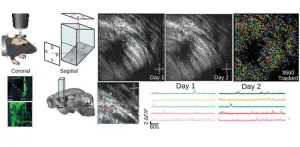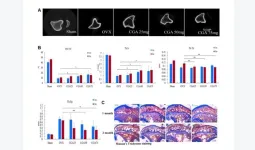(Press-News.org) University of Maryland School of Medicine (UMSOM) Dean Mark T. Gladwin, MD, announced today that Martine Rothblatt PhD, JD, MBA, Chairperson and CEO of United Therapeutics, and inventor of SiriusXM Satellite Radio, will deliver the keynote address for this year’s graduating medical student class. The UMSOM MD graduation ceremony will take place at the Hippodrome Theatre on Thursday, May 16, 2024. The ceremony will begin at 1:00 pm. Details for faculty members are here. Details for students/guests are here.
Dr. Rothblatt is a trailblazing pioneer of several innovations in biotechnology, pharmaceuticals, and satellite communications. After developing SiriusXM, she founded United Therapeutics, in an effort to find a cure for her daughter’s life-threatening illness, pulmonary arterial hypertension. Under Dr. Rothblatt’s leadership, United Therapeutics, headquartered in Silver Spring, Maryland, has become a large biotech company focused on engineering cell biology to develop new therapeutics and manufactured transplantable organs. Its monoclonal antibody has been approved to treat neuroblastoma, and its genetically modified pig hearts and kidneys were the first to be transplants into humans.
The biotech company funded and helped establish the Cardiac Xenotransplantation Program at the University of Maryland School of Medicine, which led to the world’s first two transplants of genetically-modified pig organs into living patients. Both patients were transplanted with pig hearts to treat their terminal heart failure and lived for more than a month.
The historic procedures were performed at the University of Maryland Medical Center by Bartley Griffith, MD, Professor of Surgery and The Thomas E. and Alice Marie Hales Distinguished Professor in Transplantation at UMSOM and Muhammad M. Mohiuddin, MD, Professor of Surgery and Scientific/Program Director of the Cardiac Xenotransplantation Program at UMSOM.
“We are thrilled to have Dr. Rothblatt address this distinguished class of up-and-coming physicians,” said Dr. Gladwin who is the John Z. and Akiko K. Bowers Distinguished Professor and Dean of UMSOM, and Vice President for Medical Affairs at University of Maryland, Baltimore. “Her contributions and groundbreaking developments in addressing lung disease, cancer, and the chronic organ shortage have had an immeasurable impact on the field of medicine. She’s a role model for our medical students, demonstrating that if you have the will to have a substantial impact, you can make it happen.”
An attorney-entrepreneur, Dr. Rothblatt is a tireless advocate for human rights. In 1992, she led the International Bar Association’s efforts in drafting the Universal Declaration on the Human Genome and Human Rights and has been a leading advocate for transgender acceptance. For her impacts in satellite communications, she was elected to the International Institute of Space Law and has represented the radio astronomy community’s scientific interests before the Federal Communications Commission.
Celebrated as a visionary, thought leader, and published author, Dr. Rothblatt is named “One of 100 Greatest Living Business Minds” by Forbes and “Most Powerful LGBTQ+ People in Tech” by Business Insider. Her pioneering book, Your Life or Mine: How Geoethics Can Resolve the Conflict Between Private and Public Interests in Xenotransplantation, anticipated the need for global virus bio-surveillance and an expanded supply of transplantable organs. She is also the recipient of a Lifetime Achievement Award from the Maryland Tech Council.
Dr. Rothblatt is currently the inventor and co-inventor on nine U.S. patents, with additional applications pending.
She earned her PhD in Medical Ethics with a thesis in xenotransplantation from the Royal London College of Medicine and Dentistry and earned her JD and MBA from UCLA. She also studied astronomy at the University of Maryland College Park.
About the University of Maryland School of Medicine
Now in its third century, the University of Maryland School of Medicine was chartered in 1807 as the first public medical school in the United States. It continues today as one of the fastest growing, top-tier biomedical research enterprises in the world -- with 46 academic departments, centers, institutes, and programs, and a faculty of more than 3,000 physicians, scientists, and allied health professionals, including members of the National Academy of Medicine and the National Academy of Sciences, and a distinguished two-time winner of the Albert E. Lasker Award in Medical Research. With an operating budget of more than $1.2 billion, the School of Medicine works closely in partnership with the University of Maryland Medical Center and Medical System to provide research-intensive, academic, and clinically based care for nearly 2 million patients each year. The School of Medicine has more than $500 million in extramural funding, with most of its academic departments highly ranked among all medical schools in the nation in research funding. As one of the seven professional schools that make up the University of Maryland, Baltimore campus, the School of Medicine has a total population of nearly 9,000 faculty and staff, including 2,500 students, trainees, residents, and fellows. The School of Medicine, which ranks as the 8th highest among public medical schools in research productivity (according to the Association of American Medical Colleges profile) is an innovator in translational medicine, with 606 active patents and 52 start-up companies. In the latest U.S. News & World Report ranking of the Best Medical Schools, published in 2023, the UM School of Medicine is ranked #10 among the 92 public medical schools in the U.S., and in the top 16 percent (#32) of all 192 public and private U.S. medical schools. The School of Medicine works locally, nationally, and globally, with research and treatment facilities in 36 countries around the world. Visit medschool.umaryland.edu
END
Biotechnology CEO and inventor of SiriusXM Satellite Radio Martine Rothblatt to deliver graduation address to the University of Maryland School of Medicine’s 215th graduating class
2024-03-26
ELSE PRESS RELEASES FROM THIS DATE:
ORIGAMI: anticipating the future of more connected, efficient and sustainable telecommunication infrastructures
2024-03-26
The ORIGAMI (Optimized Resource Integration and Global Architecture for Mobile Infrastructure for 6G) project is now underway. The project, funded by the European Commission under the Horizon Europe program, will spearhead architectural innovations for the next generation of 6G mobile networks, to enable innovative applications, new business models, and substantial reductions in energy consumption.
By proposing and developing three critical architecture innovations – Global Services Based Architecture (GSBA), Zero Trust Exposure Layer (ZTL), and Continuous Compute ...
Study says it’s time to highlight positive skills associated with neurodevelopmental conditions
2024-03-26
New research says the wide variety of skills displayed by people with conditions such as ADHD, dyslexia and autism should be celebrated to help reduce stigma and change society’s expectations.
Creativity, resilience and problem-solving are just some of the strengths exhibited and a study is now calling for a change in the way we think about people with neurodevelopmental conditions.
Dr Edwin Burns, senior lecturer from the School of Psychology at Swansea University, worked with academics from Edge Hill University on the study and their findings have just been published by ...
Corporations use government grants to lighten debt load
2024-03-26
Local and state governments have a variety of tools at their disposal to attract businesses or entice them to stay. One is tax relief. Austin, for example, helped lure electric automaker Tesla in part with property tax rebates worth $14 million over 10 years.
In a study released today from Texas McCombs, Dean and Accounting Professor Lillian Mills finds that another kind of government aid — cash grants — has a different kind of impact. It helps companies lighten their balance sheets by borrowing less.
Corporations ...
C-Path launches consortium for alpha-1 antitrypsin deficiency
2024-03-26
TUCSON, Ariz., March 26, 2024 — Critical Path Institute (C-Path) is excited to announce the launch of the Critical Path for Alpha-1 Antitrypsin Deficiency (CPA-1) Consortium. The CPA-1 consortium aims to accelerate drug development for alpha-1 antitrypsin deficiency (AATD), a rare disease that affects individuals and families worldwide. This will be achieved by integrating data through C-Path’s Rare Diseases Cures Accelerator–Data Analytics Platform (RDCA-DAP®) and leveraging those data for CPA-1 to collaboratively develop regulatory-grade solutions to continuously address unmet needs in drug development for this condition, including:
Generating evidence to ...
In paleontology, correct names are keys to accurate study
2024-03-26
COLUMBUS, Ohio – When the skeletal remains of a giant ground sloth were first unearthed in 1796, the discovery marked one of the earliest paleontological finds in American history.
The animal, named Megalonyx by Thomas Jefferson in 1799, was the first genus of fossil named from the United States. Thought to have roamed North America during one of the last ice ages, the extinct giant ground sloth was an herbivorous mammal resembling a large bear — at full size, it likely reached nearly 10 feet tall (3 meters) and weighed about as much as a small elephant.
The report made by Jefferson, an avid fossil collector who was known to keep ...
Imaging deep brain activity with microprisms
2024-03-26
Organisms constantly face the challenge of adapting their behavior to survive in a world full of uncertainties. This ability relies on complex neural circuits in the brain that help them find resources while avoiding danger. Scientists study how these neural circuits change over time to understand better how behaviors emerge.
One powerful way to study these changes is through optical imaging techniques that allow researchers to track the activity of individual brain cells. Traditional methods rely on observing the activity of cells directly, ...
Chlorogenic acid prevents ovariectomized-induced bone loss by facilitating osteoblast functions and suppressing osteoclast formation
2024-03-26
“[...] chlorogenic acid appears to be a promising candidate for the management of osteoporosis.”
BUFFALO, NY- March 26, 2024 – A new research paper was published in Aging (listed by MEDLINE/PubMed as "Aging (Albany NY)" and "Aging-US" by Web of Science) Volume 16, Issue 5, entitled, “Chlorogenic acid prevents ovariectomized-induced bone loss by facilitating osteoblast functions and suppressing osteoclast formation.”
Osteoporosis is a common bone disease in ...
Researchers identify protein sensor that plays a role in lung fibrosis
2024-03-26
Researchers at Weill Cornell Medicine have discovered a protein called SEL1L that plays a critical role in clearing collagen from tissue, and which may be a therapeutic target to help prevent fibrosis, scar tissue that interferes with organ function. The paper, published on Feb. 20 in Nature Communications, provides clues that could lead to drug development for diseases like lung fibrosis which have no therapeutic options currently.
Corresponding author, Dr. Michael J. Podolsky, assistant professor of medicine at Weill Cornell Medicine, has led a team that searched the human genome for genes involved in the ...
Johns Hopkins Children’s Center study shows negative impact of COVID-19 pandemic on youth minority mental health
2024-03-26
FOR IMMEDIATE RELEASE
Recent historical, political and public health events, most notably the COVID-19 pandemic, have collectively contributed to increased stress and mental health challenges among many groups of people — including adolescents in racial and ethnic minorities.
In a study published Feb. 1 in Academic Pediatrics, Johns Hopkins Children’s Center researchers investigated the pandemic’s effect on preexisting mental health disparities among youth, and found rates of depression, anxiety, and suicidal thoughts and behaviors ...
Researchers a step closer to a cure for HIV
2024-03-26
By 2030, the World Health Organization (WHO), the Global Fund and UNAIDS are hoping to end the human immunodeficiency virus (HIV) and AIDS epidemic. An international team of researchers led by Eric Arts, professor at the Schulich School of Medicine & Dentistry, and Jamie Mann, senior lecturer at the University of Bristol (U.K.), has brought us another step closer to meeting this goal, by finding an effective and affordable targeted treatment strategy for an HIV cure.
In a first, the study published ...




